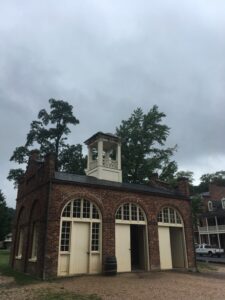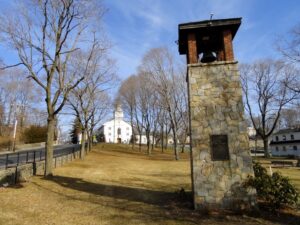John Brown’s Bell: A Meaningful Civil War Trophy
ECW welcomes guest author Walt Young
John Brown’s 1859 raid on the federal armory at Harpers Ferry is well-covered on the Emerging Civil War blog. The attack sought to strike a violent blow against the slave system, and helped to escalate tensions ahead of the 1860 presidential election. Many readers may not know, however, how a piece of Civil War loot connected to the raid symbolizes soldiers’ memories of the event.
At the end of the unsuccessful raid, John Brown and several of his men were cornered inside the Harpers Ferry armory’s fire-engine house. United States Marines under the command of Col. Robert E. Lee stormed the engine house, killing or mortally wounding three raiders and capturing the rest. The engine house, known popularly as “John Brown’s Fort,” can still be seen in Harpers Ferry today, less than a football field from its original spot. It stands, however, without its historic bell. [1]
Once the Civil War began, Harpers Ferry stood directly in the line of fire. While most of the federal armory was burned by retreating U.S. forces in the war’s first week, the engine house survived. The town was overrun by Confederates once each year from 1861 through 1864, but was otherwise held by the U.S. for most of the war. [2]

One of many U.S. regiments near Harpers Ferry during the war was the 13th Massachusetts Infantry. In late 1861 the regiment was stationed on the upper Potomac River and is recorded as fighting several skirmishes near Harpers Ferry in September and October. Its service in the area gave the Massachusetts soldiers the opportunity for a historic heist: the removal of the engine-house bell. [3]
According to the Boston Globe of December 10th, 1892, one of those who pulled off the stunt was James M. Gleason, who is recorded on the 13th Massachusetts rolls as a drummer in Co. I [4]. Gleason and his fellow “boys of Company I” decided to take the John Brown engine house’s bell to use in their own fire house in Marlborough, Massachusetts. Marlborough did not have a specific connection to the John Brown raid, but like many Massachusetts towns was very sympathetic to the abolitionist cause. [5]
The Globe report, published with thirty years’ hindsight, depicts a clandestine effort to remove the bell:
“It was on a mad, wild kind of a night, the wind was howling, the rain poured in torrents…for hours they worked, fearful all the time they might make some false move that would send their coveted prize to the ground by its weight unintentionally, or that some unusually loud noise would serve to have them detected in their efforts.”
Another participant, Lysander Parker, offered an account of the heist in 1910. According to his account, “just as it reached the edge of the roof, the rope parted and the bell dropped, and striking on a flagstone, chipped off a few pieces from the flange, but not enough however to injure the tone of the bell.” [6]

After the regiment left Harpers Ferry, Gleason successfully buried the bell, according to the Globe report, on the farm of a Mrs. Elizabeth Ensminger of Williamsport, Maryland. Gleason returned to the farm and found it almost thirty years later. The loot was brought back to Massachusetts by the soldiers and was dedicated at the John A. Rawlins GAR post No. 43 in Marlborough. The bell has since been moved to a tower in Marlborough’s Union Common, where it stands today with a historic marker describing its importance. [7]
The 13th Massachusetts went on to fight in the 1862 Maryland Campaign, serving in the Army of the Potomac until summer 1864. In taking the bell, the regiment reinforced the importance of the engine house itself. The bell had once seen a doomed final stand that attempted to overthrow an entrenched slave system. Now, it belonged to U.S. soldiers from an abolitionist town and state who helped to accomplish what John Brown never could.
Note: For further interesting reading on the town of Marlborough and the 13th Massachusetts, I found the following presentation and blog to be excellent resources:
https://www.historicmarlborough.org/in-the-civil-war
http://13thmass.org/1861/harpersferry.html
Citations
[1]: Brown and six other living raiders were in the engine house; his son Oliver had already been killed on the site. https://www.nps.gov/articles/john-browns-raid.htm
[2]: “Harper’s Ferry Burnt.” The New York Times, 20 Apr. 1861, p. 1. https://timesmachine.nytimes.com/timesmachine/1861/04/20/77963016.html?pageNumber=1
[3]: “13th Regiment, Massachusetts Infantry.” National Park Service. https://www.nps.gov/civilwar/search-battle-units-detail.htm?battleUnitCode=UMA0013RI
[4]: “John Brown’s Bell.” Boston Globe, 10 Dec. 1892, p. 8. https://www.newspapers.com/image/430669323/?match=1&terms=%22john%20brown%20bell%22; “Gleason, James M.” National Park Service. https://www.nps.gov/civilwar/search-soldiers-detail.htm?soldierId=0CE97DA1-DC7A-DF11-BF36-B8AC6F5D926A; Brodeur, Paul, and Alan Chamberlain. “Abolition, the War, the Bell.” Presentation given 26 Sept. 2011. Accessed via Marlborough Historical Society: https://www.historicmarlborough.org/in-the-civil-war. Note: the nearest news articles to this event are 30 years after the fact, as this was when the bell was recovered and the story publicized. An 1861 article in the Philadelphia Inquirer may allude to the event.
[5]: Brodeur & Chamberlain, “Abolition, the War, the Bell”; 1860 Presidential Election Results, Massachusetts. Accessed via US Election Atlas: https://uselectionatlas.org/RESULTS/state.php?year=1860&fips=25&f=1&off=0&elect=0. Note: The historical society presentation (linked in citation 7) cites the archives of the local paper as evidence that Lincoln received about 67 % of the vote in Marlborough in 1860. This is plausible given the publicly available statistics of his 62 % showing in Massachusetts.
[6]: The Story of the John Brown Bell. Published by Rawlins Building Association, 1910. Pp. 11-12. Accessed via Google Books: https://books.google.com/books/about/The_Story_of_the_John_Brown_Bell.html?id=IBg-AQAAMAAJ. Found through http://13thmass.org/1861/harpersferry.html#mozTocId501625.
[7]: “John Brown’s Bell.” Boston Globe, 10 Dec. 1892, p. 8; “John Brown Bell Dedicated.” Fall River Daily News, 29 Mar. 1893, p. 2. https://www.newspapers.com/image/590594930/?match=1&terms=%22john%20brown%20bell%22; National GAR Records Program – Historical Summary of Grand Army of the Republic (GAR) Posts by State. Accessed via https://www.garrecords.org/.

John Brown’s Bell was stole by us soldier boys
John Brown’s Bell was stole by us soldier boys
John Brown’s Bell was stole by us soldier boys
And we sure won’t give it back!
A band of thieves.
it’s time to return the bell to its rightful owner. The boys had their fun and made a good story for the folks back home, but it’s never too late to do the right thing. That would be what is called “reconciliation.”